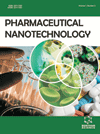- Home
- A-Z Publications
- Pharmaceutical Nanotechnology
- Previous Issues
- Volume 2, Issue 3, 2014
Pharmaceutical Nanotechnology - Volume 2, Issue 3, 2014
Volume 2, Issue 3, 2014
-
-
Frontier Lipid-Based Carrier Systems for Drug Targeting: A Laconic Review on Niosomes
More LessAuthors: Rajendra Awasthi, Sumit Kumar and Giriraj T. KulkarniSince, the first report on cosmetic applications of non-ionic surfactant vesicles by L’Oreal, numerous papers have been published reporting success of niosomes in drug delivery. Niosomes are considered as one of the most successful drug carrier system applying nanotechnology to potentiate the therapeutic efficacy and reduce toxicities of conventional therapies. Niosomes are biodegradable, nontoxic and nonionic surfactants Read More
-
-
-
Size-tuneable Nanometric MRI Contrast Agents for the Imaging of Molecular Weight Dependent Transport Processes
More LessThe purpose of the current study was to evaluate size-tuneable polymeric glycol-chitosan (GC)-DTPAGadolinium (Gd) conjugates as MRI contrast agents that can be used as a platform for imaging of molecular weight (MW) dependent transport processes. GC-DTPA-Gd conjugates of precisely controlled MWs were synthesised and evaluated in mice against Gd-DTPA using time series of high-resolution MRI images of trunk, head, Read More
-
-
-
ICH Q8 Guidelines in Practice: Spray Drying Process Optimization by 23 Factorial Design for the Production of Famotidine Nanoparticles
More LessAuthors: Anita Ayre, K.G. Lalitha, K. Ruckmani, Nilesh Khutle, Harshal Pawar, Neha Dand and Vijaya CKeeping in view the standpoint of quality by design, the current work was undertaken to optimize the process parameters in spray drying involved in the production of nanoparticles of famotidine (FAM), a drug with low oral bioavailability. Statistical experimentation approach using 23 full factorial design was utilized to optimize the spray drying process variables. Polymeric PLGA nanoparticles of FAM were formulated employing spo Read More
-
-
-
Chitosan Nanoparticles as Vehicle for Prolonged Ocular Delivery of Ofloxacin
More LessAuthors: Vijaya C, Bhaskara Rao Bandaru, K. Senthilkumar and A. Babu ThandapaniOfloxacin is a synthetic broad-spectrum fluroquinolone antibiotic, frequently used for the treatment of ocular infections. In the present study, ionic gelation technique was employed as the method of preparation of ofloxacin loaded chitosan nanoparticles using different concentrations of chitosan and sodium tripolyphosphate (TPP) and the potential of these nanoparticles in sustained ocular drug delivery was investigated. Read More
-
-
-
Defining the Properties of pH -sensitive Polymeric Micellar Ocular Delivery System of Miconazole Nitrate for the Management of Fungal Endophthalmitis
More LessAuthors: Vaishali Agrawal, Manish Kumar and Kamla PathakThe investigation was aimed at developing polymeric micellar ocular delivery system of miconazole nitrate for efficient management of fungal endophthalmitis. Drug loaded micelles of tri-block copolymers Pf 127 and Pf 68 were prepared by solvent evaporation method. The polymeric micelles (F1 to F12) were assessed for entrapment efficiency, micelle size and in vitro permeation. Formulation F2 with the lowest micell Read More
-
Most Read This Month
Article
content/journals/pnt
Journal
10
5
false
en


